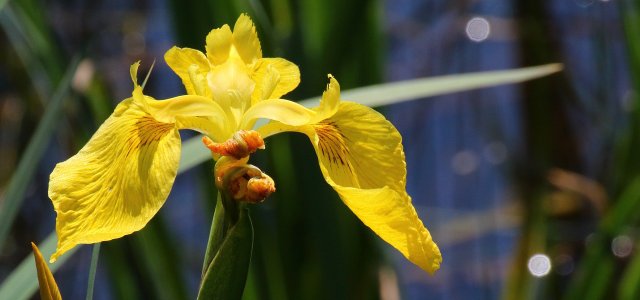Last updated on October 23rd, 2023 at 08:41 pm

Water lilies are especially popular as riparian plants around ponds. However, you can also cultivate them as a pot plant in your own four walls. In this article, you’ll learn what to consider when planting the iris species indoors or outdoors.
Its bright yellow flowers and sword-shaped leaves make the water lily a real eye-catcher both by the pond and indoors. In nature, you will find the plant, also known as swamp iris, mainly in swampy shore zones of rivers, ponds and lakes. Since the hardy perennial is very robust, it is particularly suitable for the shallow water areas of larger garden ponds. But with the right care, the water lily also thrives as a potted plant. We show you what you need to keep in mind when planting and caring for the marsh perennial.
Caution: Like most irises, the water lily is poisonous in all parts. So always wear gloves when repotting or planting them. For curious pets, the swamp iris can quickly become a danger. Therefore, it is better not to keep the lily species as a houseplant if you have dogs or cats, or even with small children.
Planting water lily in the garden and in the pot
In domestic gardens, the water lily is best planted as a bulb or a pre-grown plant in a plant container in the marshy shore area of ponds. The best time for this is between the end of July and the beginning of October. If you want to cultivate the water lily as an indoor plant, you can also use tubers or young plants from the garden center. The following tips should also be followed if you want to successfully plant the water lily in the garden or indoors:
- Location: A sunny to semi-shady spot in the garden or indoors is best for the water lily. However, you should avoid full sun, especially for potted specimens. The water lily can tolerate dry heating air for a certain period of time, but then you will have to water it more frequently. In the garden pond, it thrives especially well in the sump zone at a water depth of up to 20 centimeters.
- Soil: In the garden, it is best to plant the water lily in soil that is as moist and marshy as possible, with a high nutrient content. If you want to cultivate the perennial in a pot, conventional potting soil, which you can enrich with a little compost, is also sufficient.
Plant water lily in the garden: In the wild, the water lily quickly begins to proliferate. If you want to prevent this, you should place the young plants in special plant baskets in the ground.
- Dig several small planting pits in the shallow water area of the pond at a distance of about 50 centimeters.
- Sprinkle the holes with some horn meal, which is especially fine-grained horn shavings.
- Now place the seedlings or tubers in the moist soil with the roots facing down.
- Fill the excavated soil back into the planting holes.
Plant water lily as a houseplant:
- Place the young water lily with the root ball in a bucket of water and let it soak until no more air bubbles rise.
- Select a planter with drainage holes and place a drainage layer of broken clay or pebbles at the bottom.
- Enrich some potting soil with compost and fill a thin layer of the mixture into the pot.
- Then place the water lily in the planter and fill it up with the remaining soil.
- Lightly press the top layer of soil and water the water lily generously.
The right care for the water lily – outdoors and indoors
In the right place, the water lily will not cause you much extra work. Even for beginners, the care of the swamp perennial is therefore well manageable. It is only important that you cover the high water requirements of the lily. With the following tips you can ensure that the water lily thrives both in the garden and in the pot:
- Watering: If the water lily is in shallow water or marshy soil, you usually don’t need to water it at all. Especially with potted plants, however, you must make sure that the soil never dries out. As an indoor plant, you should therefore water the water lily regularly with low-calcium water, preferably rainwater. Important: You need good drainage in the pot to prevent waterlogging. This would not only mean the end of your plant in closed rooms, but also promote mold. Additionally, it helps the water-loving lily species if you spray it with water regularly.
- Fertilizing: The water lily does not need additional fertilizer, neither indoors nor in the garden. If it shows signs of deficiency, such as withered or sparsely growing flowers, you can support it with a little liquid fertilizer for pond plants. However, the perennial does not tolerate mineral fertilizers.
- Repotting: Water lilies growing in pots should always be repotted when the planting container becomes too small. The best way to recognize this is when the first root tips grow out of the holes in the bottom of the pot. Then place the plant in a larger pot with fresh peat-free potting soil and some horn shavings. Don’t forget to add a drainage layer of pebbles or clay shards at the bottom of the pot again.
- Pruning: For water lilies that grow outside, the above-ground parts of the plant will retreat into the rhizome, the rootstock that grows underground, in the fall. Now you can cut the rest of the plant back to just above the ground. Withered flowers can be removed at any time.


